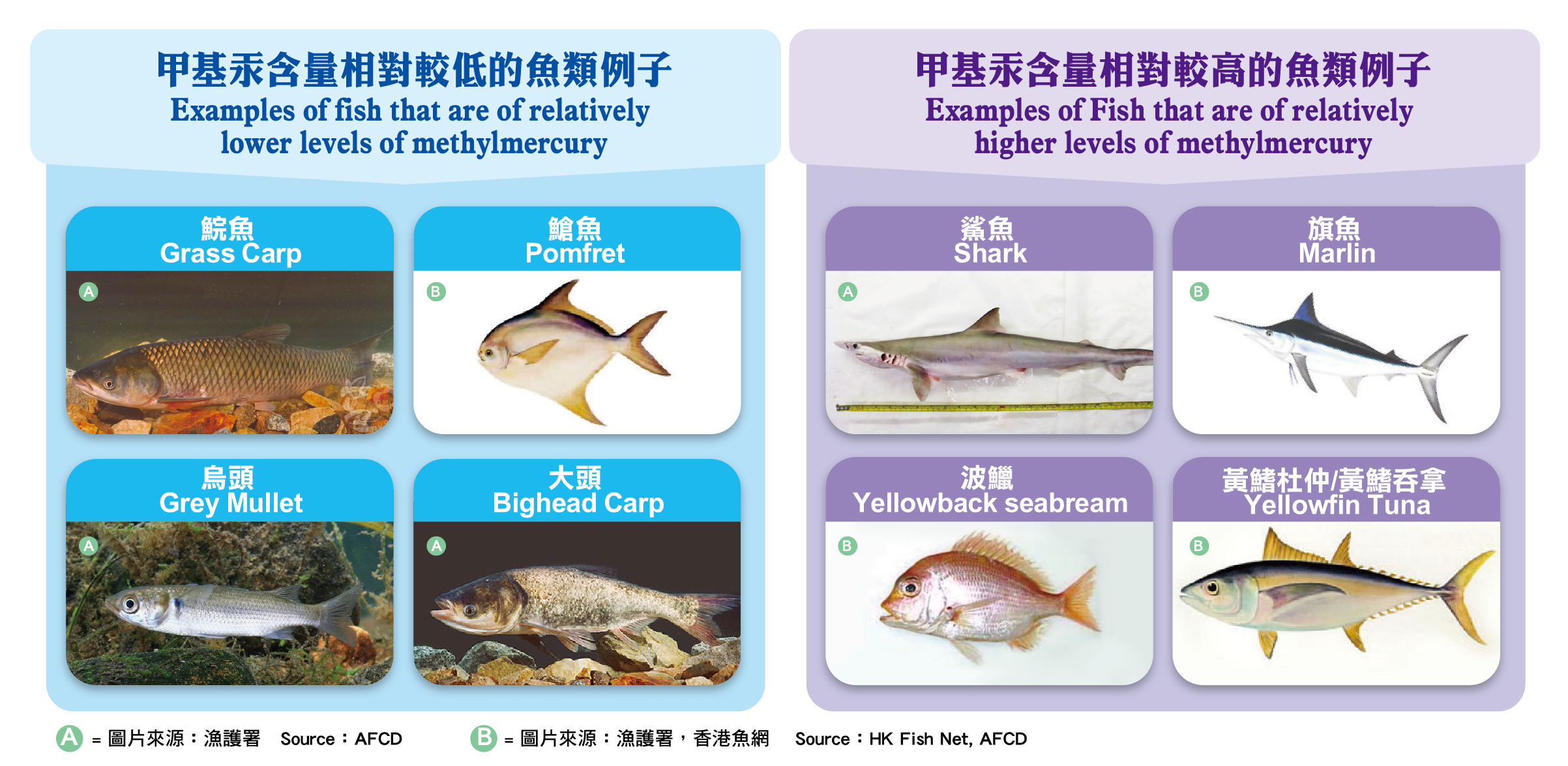
Food Safety Focus (220th Issue, November 2024) – Article 1
Metallic Contaminants in Food Part II – Methylmercury
Reported by Arthur YAU, Scientific Officer,
Risk Communication Section, Centre for Food Safety
After covering lead and cadmium in the last issue, we will look at methylmercury in food, its health implications and especially how to be safe when consuming fish.
What is Mercury?
Mercury is a metallic element that occurs naturally. Through natural processes (e.g. volcanic activities, rock weathering) and human activities (e.g. coal burning, industrial processes, waste incineration, mining), it can gradually spread across the environment. Metallic mercury can combine with other chemical elements like chlorine, sulphur, etc. in the environment to form inorganic mercury compounds. Bacteria can also convert mercury to its organic form methylmercury. Methylmercury can then bioaccumulate in fish and shellfish, which makes these foods a main source of human exposure. Additionally, methylmercury can also move up the food chain. For example, larger, older fish that eat smaller fish have higher methylmercury levels than smaller fish that eat planktons.
Why is Methylmercury a Concern?
Methylmercury affects the central and peripheral nervous systems and brain development. The intake of large predatory fish that contain high amounts of methylmercury by pregnant women before or during pregnancy can expose foetuses to methylmercury while they are still in the womb. This is a significant issue since methylmercury is effectively transferred from the mother to the foetus through the placenta. The rate of absorption through ingestion varies from almost none for metallic mercury, 10 to 30% for inorganic mercury and around 95% for methylmercury.
The cognitive thinking, memory, attention, language and fine motor and visual spatial skills of children may be affected by exposure to methylmercury. Certain groups, particularly women of childbearing age and small children, are recommended by the World Health Organization (WHO) to limit their intake of fish that are known to have high amounts of methylmercury.
Eating Fish is Beneficial to Health
Eating fish as part of a balanced diet offers significant health benefits. Fish is an excellent source of protein, essential omega-3 fatty acids, and various vitamins and minerals. More importantly, fish contains docosahexaenoic acid (DHA) and eicosapentaenoic acid (EPA), which can reduce the risk of coronary heart disease and are vital for foetal brain development. Women and young children in particular should include fish in their diets.
Is there a Safe Level for Methylmercury in Pregnant Women or Women of Childbearing Age?
The WHO's Joint FAO/WHO Expert Committee on Food Additives (JECFA) has established a safety reference value (Provisional Tolerable Weekly Intake, PTWI) of 1.6 micrograms per kilogram of body weight per week in 2007 based on developmental neurotoxicity in order to safeguard the developing foetus. For adults other than women of childbearing age, methylmercury intake of up to two times higher than the PTWI would not pose any risk of neurotoxicity. If a woman regularly consumes fish that contain high amounts of methylmercury, it can accumulate in her body gradually. While mercury can be excreted from the body naturally mainly through faeces, it usually takes 45 to 70 days for the methylmercury levels to reduce to half in adults. Consequently, it may be present in a woman even before she becomes pregnant. Therefore, women planning for pregnancy should also be aware of mercury in food.

Figure : Examples of fish that are of relatively lower levels of methylmercury (left) and fish that are of relatively higher levels of methylmercury (right)
(Photo source: Agriculture, Fisheries and Conservation Department (AFCD))
Choose Wisely to Reap the Benefits of Fish Consumption and to Reduce the Risk
In general, smaller fish [i.e. less than one catty (about 605 g)], farmed fish and freshwater fish have lower levels of mercury. According to the results of the Total Diet Study conducted by the Centre for Food Safety (CFS), bighead carp, pomfret, dace (minced), salmon, grey mullet, sole fillet and grass carp were found to contain relatively low levels of methylmercury. However, larger fish (often with longer lifespans), as well as predatory species like swordfish and shark, tend to have higher methylmercury concentrations due to bioaccumulation. Consume a variety of fish that are lower in methylmercury. Eat one to two servings of fish per week (1 serving = 150g) within a balanced diet to reap the health benefits, and limits the consumption of fish that contain high amounts of methylmercury at the same time. Furthermore, methylmercury levels in canned tuna are lower than in fresh tuna mainly because different species or smaller tuna (e.g. skipjack tuna) are used. It is recommended to consume no more than 5 cans (about 140g/can) of skipjack tuna a week, while the limit for albacore tuna should be no more than 3 cans per week. It is common for women in Hong Kong to consume fish soup after childbirth or when lactating. A study on the risks and benefits of fish soup consumption conducted by the CFS suggested that it is safe to drink fish soup. Nevertheless, eating large predatory fish, including drinking soup prepared with those predatory fish, should be avoided.







